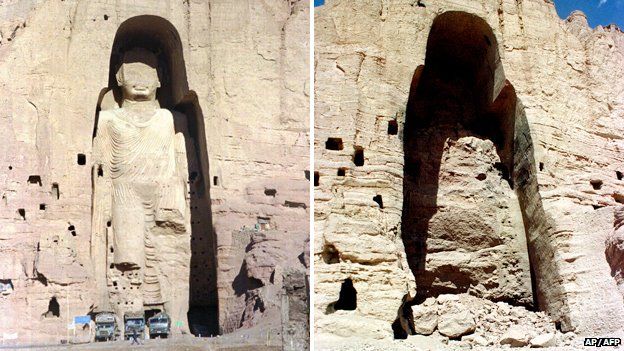by Hugh Fitzgerald

If those who work in our museums want to enlighten audiences about Muslims and Art, they should consider two aspects of the subject that have received practically no attention.
First, a museum wanting to treat the subject of Islam and Art should give visitors a sense of what Islam has meant for much of the world’s art. The greatest destruction of art in the history of the world is that wrought by Muslims, over 1400 years, on the art (architecture, artifacts), sacred and profane, of non-Muslim civilizations. Some of that art has been religious in nature: the thousands of Buddhist and Hindu temples and temple complexes in India razed by Muslims; the thousands of churches vandalized, razed, or turned into mosques, in North Africa and the Middle East; or more recently, the 58 synagogues in Jerusalem’s Old City, one dating back to the 13th century, and others hundreds of years old, all destroyed by Muslims between 1948 and 1967 — need to be shown, before and after their destruction.
In the case of the churches and Hindu and Buddhist temples, drawings based on verbal descriptions will have to do, since no “before” photographs exist; in the case of the synagogues in the Old City, such “before” and “after”photographs are available. Other photographs could show the vandalized mosaics and frescoes inside the Hagia Sophia in Istanbul (and similar vandalism that was done to the Hagia Sophia in Trebizond). There might be photographs of the National Museum in Kabul, before and after the Taliban got through with it. Similar before-and-after photographs of the National Museum of Iraq, showing what happened to it in the days following the American invasion (and civil order broke down in the immediate chaos), when Muslim Arabs had a chance to show their appreciation of pre-Islamic artifacts, could also be on display.
Finally, photographs of two recent acts of massive destruction by Muslims deserve to end the exhibit. On one wall of the last gallery, photographs of the Bamiyan Buddhas, in their undamaged state, and as they were being prepared for destruction with explosives, and finally, a photograph of what little was left of those giant statues after the destruction. In the same gallery, on the opposite wall, photographs of the most recent act of Muslim art appreciation, showing what the Islamic State has done to the Roman temples and triumphal arches in Palmyra, a World Heritage Site, could be mounted. Pride of place should be given to the Temple of Baal (Bel), described by many as the premier archeological site in Syria, which now, thanks to ISIS fanatics, lies completely in ruins.
That’s an exhibit worth putting on, for it brings to the public’s attention something that is perfectly appropriate for a major art museum — more Metropolitan than MoMA — to provide: that is, to display, and to wordlessly deplore in photographs and reconstructions, the deliberate and sustained destruction of many of the world’s artistic treasures, starting nearly 1400 years ago, and continuing right up to the present day, by Muslims. For this threat is not only a thing of the past, nor a threat only in Muslim-majority countries. It is a living, breathing threat today, and that threat has increased pari passu with the growth in the Muslim population in Europe. For why should Muslims, once they achieve effective numbers and power, not act as they always have acted when given the chance?
Such an exhibit devoted to giving visitors a better sense of that destruction, of which few are sufficiently aware, would have a salutary effect. It would make non-Muslims more conscious of one of the possible consequences of the takeover, through demographic conquest, of much of Western Europe. The word “takeover” does not necessarily require having attained a majority. A determined and cohesive Muslim minority could work its will long before that. Works of art that offend Muslim sensibilities would be vulnerable to demands for their removal from public view, or worse, could be objects of vandalism or destruction. It is disturbing to think what might happen, in some imaginable future, with the removal or destruction of art deemed haram, from the Louvre, the Prado, the Alte Pinakothek, the Rijksmuseum, the National Gallery, the Uffizi. That should concentrate European minds on the possibility, painful to consider and yet perfectly plausible, of Muslims in the future treating the art of non-Muslims in Europe as they have treated such art elsewhere (in North Africa, the Middle East, Anatolia, India) in the past.
First published in Jihad Watch.
- Like
- Digg
- Del
- Tumblr
- VKontakte
- Buffer
- Love This
- Odnoklassniki
- Meneame
- Blogger
- Amazon
- Yahoo Mail
- Gmail
- AOL
- Newsvine
- HackerNews
- Evernote
- MySpace
- Mail.ru
- Viadeo
- Line
- Comments
- Yummly
- SMS
- Viber
- Telegram
- Subscribe
- Skype
- Facebook Messenger
- Kakao
- LiveJournal
- Yammer
- Edgar
- Fintel
- Mix
- Instapaper
- Copy Link









